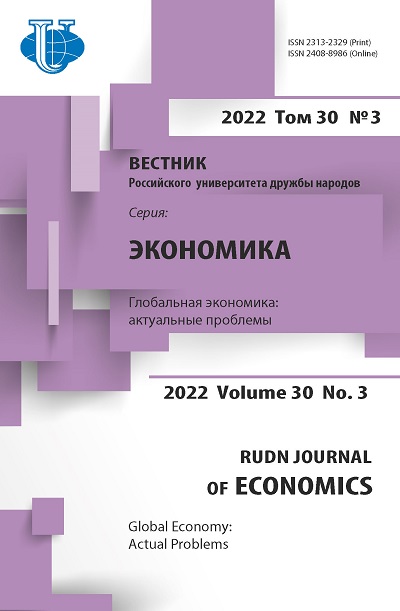Влияние фактора цифровизации на формирование и развитие человеческого капитала в развивающихся странах
- Авторы: Мамахатов Т.М.1,2, Маллах Д.М.3
-
Учреждения:
- Институт Дальнего Востока Российской академии наук
- Центр изучения проблем безопасности Российской академии наук
- Южный федеральный университет
- Выпуск: Том 30, № 3 (2022): Глобальная экономика: актуальные проблемы
- Страницы: 317-328
- Раздел: ЭКОНОМИЧЕСКИЕ И СОЦИАЛьНЫЕ ТРЕНДЫ: РАЗВИТИЕ МИРА ПОСЛЕ COVID-19
- URL: https://journals.rudn.ru/economics/article/view/32146
- DOI: https://doi.org/10.22363/2313-2329-2022-30-3-317-328
Цитировать
Полный текст
Аннотация
Развивающиеся страны, особенно африканские, продолжают отставать в своем стремлении к развитию человеческого капитала в эпоху цифровизации, в связи с этим необходимо изучить уровень влияния факторов цифровизации на формирование и развитие человеческого капитала. В том числе следует оценить значение доступа к результатам цифровизации в развивающихся странах Африки. Также необходимо разработать рекомендации, которые могут способствовать успеху благодаря высоким инвестициям в эти ключевые факторы. Цель исследования заключается в анализе влияния факторов цифровизации на формирование и развитие человеческого капитала в контексте 14 развивающихся стран. Авторы использовали коэффициент корреляции Кендалла (tau-b) для проверки взаимосвязи переменных, относящихся к ранжированию EDI и развитию человеческого капитала. Результаты исследования показали, что Индекс человеческого капитала (HCI) и рейтинг EDI имеют отрицательную корреляцию. Приведены рекомендации, как развивающимся странам следует инвестировать в человеческий капитал и цифровые технологии, поскольку создание инфраструктуры, необходимой для доступа к цифровым технологиям, способствует развитию человеческого капитала.
Об авторах
Тлеш Муратович Мамахатов
Институт Дальнего Востока Российской академии наук; Центр изучения проблем безопасности Российской академии наук
Автор, ответственный за переписку.
Email: tmmamakhatov@gmail.com
ORCID iD: 0000-0001-7212-6831
кандидат экономических наук, ведущий научный сотрудник Центра изучения стратегических проблем Северо-Восточной Азии и Шанхайской организации сотрудничества Института Дальнего Востока РАН; научный сотрудник Центра изучения проблем безопасности РАН
Российская Федерация, 117997, Москва, Нахимовский проспект, д. 132; Российская Федерация, 117335, Москва, ул. Гарибальди, д. 221бДжеймс Мохаммед Маллах
Южный федеральный университет
Email: jamesmanaffmallah@gmail.com
аспирант Российская Федерация, 344006, Ростов-на-Дону, ул. Большая Садовая, д. 105/42
Список литературы
- Azu, N.P., Jelivov, G., Aras, O.N., & Isik, A. (2021). Influence of digital economy on youth unemployment in West Africa. Transnational Corporations Review, 13(1), 32-42. https://doi.org /10.1080/19186444.2020.1849936
- Banga, K., & te Velde, D.W. (2018). Digitalisation and the Future of Manufacturing in Africa. https://doi.org/10.1596/978-1-4648-1444-0
- Bara-Slupski, T.K. (2016). Holistic Approach: paradigm shift in the research agenda for digitalisation of healthcare in Sub-Saharan Africa. The African Journal of Information Systems, 8(4), 3. https://doi.org/10.1080/02681102.2018.1461057
- Baumöl, U., & Bockshecker, A. (2017, July). Evolutionary change of higher education driven by digitalization. In 2017 16th International Conference on Information Technology Based Higher Education and Training (ITHET) (pp. 1-5). IEEE. https://doi.org/10.1109/ITHET.2017.8067811
- Chiang, C.T. (2020). Developing an eMarketing model for tourism and hospitality: a keyword analysis. International Journal of Contemporary Hospitality Management. https://doi.org/10.1108/IJCHM-03-2020-0230
- Gil-Garcia, J.R., & Hassan, S. (2008). Structure Theory and Government IT. https://doi.org/10.4018/9781599048574.ch035
- Gora, Y. (2020). An exploratory, qualitative study on the factors which influence South African millennials to shop online, using an in-depth interview. The IIE. https://doi.org/10.1186/s40852-018-0090-7
- Großer, B., & Baumöl, U. (2017). Why virtual teams work-State of the art. Procedia computer science, 121, 297-305 https://doi.org/10.1016/j.procs.2017.11.041
- Hsu, I.C., Yeh-Yun Lin, C.A.R.O.L., Lawler, J.J., & Wu, S.H. (2007). Toward a model of organizational human capital development: Preliminary evidence from Taiwan. Asia Pacific Business Review, 13(2), 251-275. https://doi.org/10.24940/ijird/2019/v8/i1/DEC18038
- Ivanova, V.V. (2019). Management of Digital Information Technologies in Digital Economy. https://doi.org/10.21272/mer.2019.85.08
- Kendrick, J.W. (1994). Total capital and economic growth. Atlantic Economic Journal, 22(1), 1-18. https://doi.org/10.1007/BF02301693
- Kohtamäki, M., Parida, V., Patel, P.C., & Gebauer, H. (2020). The relationship between digitalization and servitization: The role of servitization in capturing the financial potential of digitalization. Technological Forecasting and Social Change, 151. https://doi.org/10.1016/J. TECHFORE.2019.119804
- Korovkin, V. (2019). National digital economy strategies: A survey of Africa. ORF Issue Brief. https://doi.org/10.1093/icc/dtab053
- Lüneborg, J.L., & Nielsen, J.F. (2003). Customer-focused technology and performance in small and large banks. European Management Journal, 21(2), 258-269. https://doi.org/10.1016/j.indmarman.2010.02.001
- Matsuyama, K. (2009). Structural change in an interdependent world: A global view of manufacturing decline. Journal of the European Economic Association, 7(2-3), 478-486. https://doi.org/10.1162/JEEA.2009.7.2-3.478
- Matthess, M., & Kunkel, S. (2020). Structural change and digitalization in developing countries: Conceptually linking the two transformations. Technology in Society, 63, 101428. https://doi.org/10.1016/J.TECHSOC.2020.101428
- McBride, N., & Stahl, B.C. (2010). Analysing a national information strategy: a critical approach. International Journal of Intercultural Information Management, 2(3), 232. https://doi.org/10.1504/IJIIM.2010.037863
- Minges, M., Briceño-Garmendia, C., Williams, M., Ampah, M., Camos, D., & Shkratan, M. (2008). Information and communications technology in sub-Saharan Africa: A sector review. Background paper, 10.
- Ndemo, B., & Weiss, T. (2017). Making sense of Africa’s emerging digital transformation and its many futures. Africa Journal of Management, 3(3-4), 328-347. https://doi.org/10.1080/23322373.2017.1400260
- Nicholson, J.S. (1891). The Living Capital of the United Kingdom. The Economic Journal, 1(1), 95-107. https://doi.org/10.2307/2955843
- Tanriverdi, H., & Venkatraman, N. (2005). Knowledge relatedness and the performance of multibusiness firms. Strategic management journal, 26(2), 97-119. https://doi.org/10.4236/ojbm.2021.96168
- Teixeira, P.N. (2014). Gary Becker’s early work on human capital - collaborations and distinctiveness. IZA Journal of Labor Economics, 3(1), 12. https://doi.org/10.1186/s40172-0140012-2
- Tippins, M.J., & Sohi, R.S. (2003). IT competency and firm performance: is organizational learning a missing link? Strategic management journal, 24(8), 745-761. https://doi.org/10.1002/smj.337
- Tuguskina, G.N. (2019). The Role Of Human Capital In The Digital Economy. https://doi.org/10.15405/epsbs.2019.03.95
- Wade, R.H. (2016). Industrial Policy in Response to the Middle-income Trap and the Third Wave of the Digital Revolution. Global Policy, 7(4), 469-480. https://doi.org/10.1111/17585899.12364















